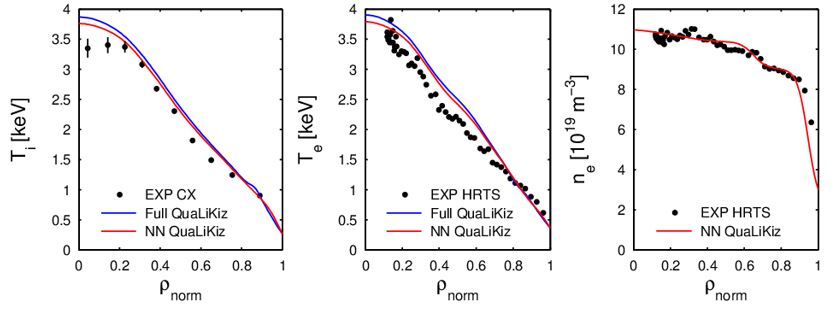We aim to provide a first-principle based and realtime capable turbulent transport model. However, achieving this by further model reduction can result in a trade off with a decrease in physics fidelity. The challenge is thus to circumvent these conflicting constraints of accuracy and tractability. We achieve this by the emulation of quasilinear transport models using machine learning techniques. This emulation is achieved by nonlinear regression of compiled databases of transport model output. We focus on multilayer perceptron neural network techniques.
The calculation time of trained neural network output is sub-millisecond for full radial profiles of turbulent transport fluxes. This is sufficient for realtime prediction, bringing first-principle transport modelling into the tokamak control room. Applying these techniques in tokamak transport modelling opens up a plethora of possibilities and innovation in realtime controller design and validation, scenario preparation, and discharge optimization. We collaborate closely with the Control Systems Technology group at the Technical University of Eindhoven. ITER and DEMO envisions such integrated model-based control as a critical portion of their infrastructure. The applications are:
- High throughput transport physics analysis
- Efficient offline discharge design and optimization in integrated modeling frameworks
- Model-based controller design for tokamak profile control
- Closed-loop simulations to validate the designed controllers
- Realtime simulations to verify the measured plasma evolution and warn a supervisory system of any unexpected deviations during the discharge (e.g. disruption control)
- Faster-than-real-time simulation for realtime discharge performance optimization on-the-fly, e.g. confinement maximization, MHD avoidance, W-accumulation control, internal transport barrier control

The neural network is a proof of principle [J.Citrin, S. Breton et al., Nucl. Fusion 55 092001 (2015)] based on a 4D input dimension scan.
In spite of the reduced dimensionality, the neural network is a good emulation of the original model in this regime. The neural network
transport model is 6 orders of magnitude faster than QuaLiKiz, and 12 orders of magnitude faster than full nonlinear modelling.
Currently, we are generalizing the neural network emulation by significantly expanding the input dimensionality of the training sets